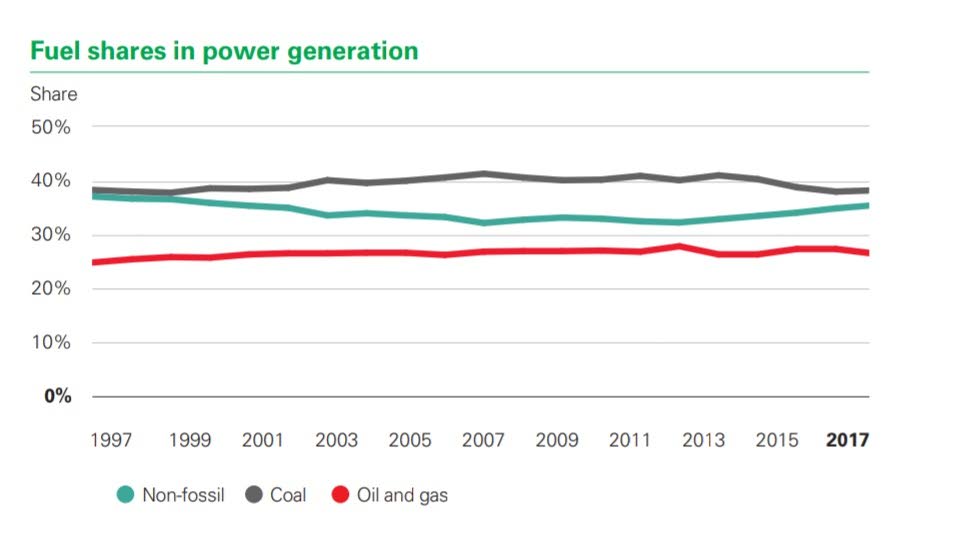World still consumes too much energy

THE MOST WORRYING of the statistics shared during the British Petroleum (BP) review of world energy, last Thursday, came in the form of three relatively straight lines illustrating the fuel share in power generation between 1997 and 2017.
Those three lines indicated – despite the recent demand for action to be taken to lessen fuel emissions, and regardless of the strides made in the use of non-fossil fuels, and renewable energy – nothing has changed in the way the world consumes fuel for power generation in the past 20 years.
The chart was explained to public and private stakeholders at the BP building on Victoria Avenue, Port of Spain by Spencer Dale, group chief economist for BP.
“The share of coal in the global power sector last year was 38 per cent. Guess what? The share of coal in the power sector 20 years ago was exactly the same – 38 per cent.”
“The same is also true for non-fossil fuels. The share in 2018 was identical 28 years ago. Yes, we’ve seen really rapid growth in renewable and solar power but that has been offset by a declining share in nuclear power, so the global share among fossil fuels hasn’t changed.”

The way in which the world consumes fuel to generate power and how little that has changed has serious implications, according to Dale, especially when compared to the rapid growth in demand for power worldwide, which grew by 3.5 per cent.
According to the 2019 statistical review, the growth in energy consumption worldwide increased by 2.9 per cent. The resulting demand for fuel to create that energy also climbed, and, because of how the world generates its energy which in itself results in carbon emissions, the growth of carbon emissions from energy use grew by two per cent – the fastest rate of growth for seven years.
Natural gas consumption rose by 195 billion cubic metres, and electricity generation rose by 3.7 per cent, but these statistics were offset by the fact that coal still accounted for the largest share of use for power generation. About 38 per cent of the world’s power is generated through the use of coal.
The top three contributors to this massive growth in demand for energy, according to BP’s statistics, are China, the United States and India. China accounted for 34 per cent of the growth in the world’s energy consumption, followed by the US which accounted for 20 per cent.
The rapid growth in demand for energy and its resulting carbon emissions comes among an equally rapid growth in demand for action to be taken against carbon emissions, one of the key factors in climate change.
Reuters reports in May indicated close to a million young people in 110 countries took part in a worldwide strike called by teenagers who feared adults were dragging their feet in their efforts against carbon emissions. Children as young as eight walked out of classrooms, and engaged in the strike.
More strike action is expected as people around the world are planning similar action between September 20-27.
However, according to Dale, the demand for action against climate change would not be so easily met, especially if the focus is not placed on the right sector.
Dale explained that for the world to even keep carbon emissions at its current rate, stakeholders would have to do twice as much work than they are already doing.
“Suppose we do it all by growing renewable energy far more quickly. How much would we have to grow over the last three years in order to hold the carbon emissions at a constant? Roughly renewables would have had to grow twice as quickly than they actually did,” he said.
Over the last three years, the use of renewable energy grew by 800 terrawatts per hour (TWh). Dale said for the world to reduce carbon emissions, so that levels would remain as it has for the past three years, renewable energy would have to grow by 1,800 TWh.
“We would have had to replicate the entire system for renewable energy in China and the US combined for the past three years just to maintain the carbon levels at this point.”
He said, however, if the world were to divert ten per cent of their consumption of coal in energy consumption and use natural gas instead, it would have the same effect.
“Coal is such a large portion of the power sector, shifting it into natural gas would be an enormous impact in terms of reduction. If you use natural gas altogether, instead of coal, you would reduce carbon emissions by about half.”
But as it stands, the demand for energy continues to trump the obvious need for a clean environment even in developing countries where power demand is growing rapidly. Dean said in the effort to provide developing countries with power and to maintain the needs of developed countries – which already consume a large amount of energy – using renewable energy to electrify the world would be critical to the process.
But it would not be enough. Dale suggested a multi-faceted approach which included coal to gas switching, increase in the adoption of carbon capture, utilisation, and storage (CCUS), an increase in nuclear energy and an increase in the adoption of an attitude geared toward energy efficiency.
“We often think about electrification and that it would do really good in the reduction of carbon but it would only do good if it goes hand in hand with decarbonisation of power markets.”


Comments
"World still consumes too much energy"